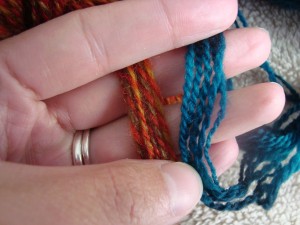Entries tagged with “Spinning”.
Did you find what you wanted?
Fri 29 Jun 2012
I may have mentioned that knitting time has become commute time. I can usually only knit for about half of the trip, since the second half is on a more crowded subway train. Still, I am getting quite a bit of knitting done. I’m thinking of counting my commute time in sweaters knit rather than hours. Behold the results of this week:
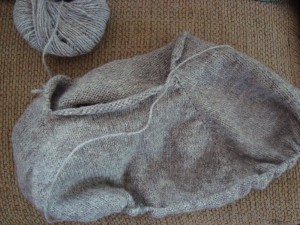
That’s the top of a raglan sweater, a little hard to see in its crunched-up on the needles state. This is the yarn spun from the Harriet fleece that I’m making for Mike’s sweater. I’m about half way to the sleeve split, I’d say. I ended up having to go down to size 2 needles to get the fabric I wanted, but the knitting is pretty fast anyway since it’s all stockinette.
So fast, in fact, that I need to get some spinning done before I can continue. All of the Harriet fleece is spun already, but I’m a little short on yardage and so decided to make a wide band at the shoulders with some of the leftover MacGyver yarn from Branden’s sweater. That was all fine and good, until I went and found the MacGyver yarn and realized that it was spun at a heavier weight.
I thought that the two yarns were about the same, but never did any sampling to check because I wasn’t originally planning to put them together. When I looked at the two yarns, they are very clearly different.
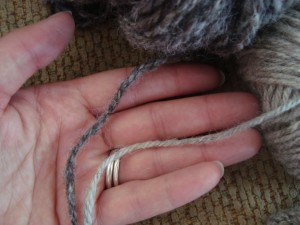
Comparing the gauge of the two sweaters, I am pretty sure I’d have distortion around the stripe if I were to use the MacGyver yarn directly. What to do?
Well, it occurred to me after thinking about it for a while that I’ve never tried yarn reconstruction. I’ve heard of others splitting yarns up into individual plies and respinning or repurposing them, but it’s not yet in my bag of tricks. It then occurred to me that it should be.
So, I unspun my three ply yarn by running it back through the wheel, and then wound the three plies onto separate bobbins. Then I took two of them and plied them back together, to make a yarn that really is very close to what I’m going for.
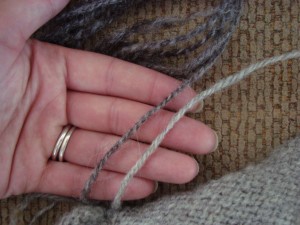
I now have one skein of yarn unplied, and am working on winding those live singles onto separate bobbins. It was a lot easier in my 6-yard sample than it is for a whole skein, but it is slowly progressing. I’m thinking I’d better hurry up, or I’m not going to have knitting for my commute next week!
Fri 6 Apr 2012
…makes Jack a dull boy, right?
Since most everyone seemed to be leaning toward play (and since I had some pretty strong leanings in that direction myself), I decided to try spinning the second half of the gradient as a short repeat yarn.
As instructed, I kept it simple. No overthinking…not even a bit. (Who me? Overthink? Never!)
I split the top along its full length, making 10 very narrow strips.
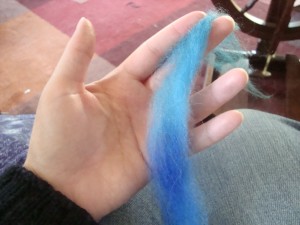
Then I spun them, one after the other until I ran out. (I was also careful to keep the cats out of the pile while I was spinning. This was critical, and proved to require more attention than I expected. Apparently lots of little strips of fiber = warm nest in the mind of a cat.)
I chain plied the singles like I did for the first skein, and ended up with about 2 yard lengths of each color (compared to about 20 yards per color in the previous skein). You can see the difference in the color distribution here:
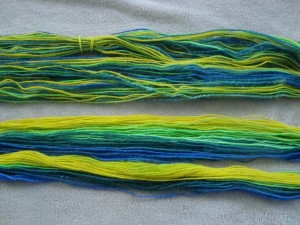
And the two skeins together:
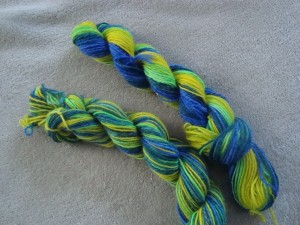
True to form, I like the long repeat version better in the skein, but I’m really not sure which I would prefer in the knitting.
I’d started out spinning this yarn expecting it to become a pair of socks, so I spun a (slightly heavy) sock weight. But then I was thinking about it, and I wasn’t sure that I wanted that long a gradient along the length of just one sock. That’s where the possibility generator kicked in and suggested that shorter repeats would be nice, so that there would just be a few rounds of each color in repeating stripes.
For a sock, I think I’d much prefer the shorter repeat version. I’d guess that there would be 3, maybe 4 rows per color, and then the colors will repeat every half inch or so, for the full length of the sock.
If I were to knit this into a shawl or a larger garment, then the long repeat version would look really good striped with a darker solid color. Of course, you could also alternate sections of long and short repeats to get all kinds of interesting combinations, too.
Because this is me, I no longer want to use this yarn for socks. My brain somehow manages to take a sharp left turn every time I sit down to think about knitting socks. Sweaters and shawls and bigger things are just much more exciting for some reason. (Also, I like my socks to match, which might be hard with this yarn now.)
Last night, I was having visions of a stranded colorwork bag, with the bright yarn worked on a dark blue background. But today, a mischievous little voice is suggesting that they would look very nice woven.
I said I didn’t overthink the spinning. I didn’t promise anything at all about the using of the yarn.
(Of course, all these ideas just mean more decisions, but that woven idea is pretty sticky. I think it might win.)
Sun 25 Mar 2012
The striped shawl sweater has been slowly creeping slowly forward with the same knit-rip-knit pace. I’m past the striped section and have been working short rows to transition into the main body color. I started out decreasing one stitch for every three rows that I knit, which looked pretty good at first, but looked less good as the fabric grew. I worked short rows for both of the sleeves and half of the body before deciding that it looked a little too puffy.
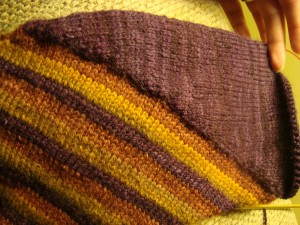
See how there’s a bump at the edge of the dark fabric? Well. It was bothering me. So I ripped it out, and reknit the short rows, decreasing one stitch for every 2 rows instead.
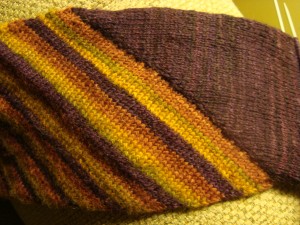
Isn’t that better?
I’ve since redone the short rows, and finished the main body section. I had to spin some more yarn to make it, but I am very happy with how it’s coming out.
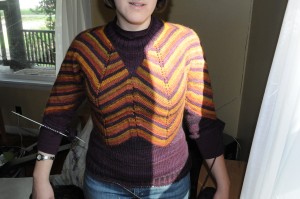
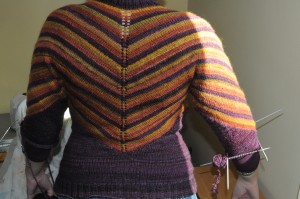
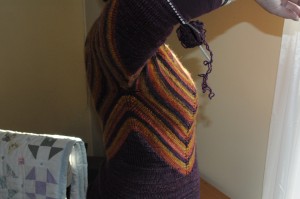
I am to the elbows on the sleeves and I am running on yarn fumes, so I’ll need to spin up another hundred yards or so to finish it off. I hadn’t counted on the short row decreases to add so much shaping, and I added a few of my own, which turns out to have been unnecessary. The final fit ended up a tiny bit tighter than I’d like, but I think it will loosen up with blocking and I don’t think it’s enough of a problem to rip back again. This project may finally be in the home stretch. All that’s left is finishing the sleeves, and then steeking the front to install the zipper. It’s getting close!
While I’ve been knitting the striped shawl, I’ve been keeping my spinning wheel busy finishing up the green for the fall colors sweater.
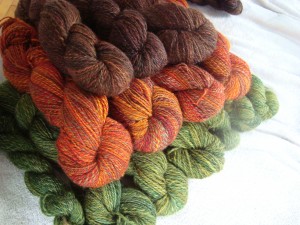
It’s all finished now, and will be ready to go as soon as I settle on a design. I’d like to say that it will be simple to make up for the last, but somehow I think that’s unlikely. (I’m still leaning toward the last design in this post, which will involve both steeking and a little bit of tailoring, and I’m thinking it likely that it will also have some rather experimental colorwork going on. Never a dull moment around here.)
Amazingly, that brought me to the end of what had seemed like a very long spinning queue, and suddenly it was time to start spinning the wool for Mike’s sweater, months earlier than I had planned. He’s a close friend of ours, and I think this may officially be the first big thing I’ve knit for someone outside of the family (mostly I knit just for Branden and I). We usually stay at Mike’s house over Christmas, and he was especially taken with Branden’s MacGyver sweater this year. He kept asking how long it took to make a sweater, from spinning the wool through to wearing it. I didn’t know, but I’ve decided to find out by spinning up the rest of the Shetland that I bought from that farm. Since Mike is also of an engineering bent and loved the MacGyver angle, I’ll also work in some of the leftover MacGyver yarn, probably as colorwork or stripes around the shoulders. For now, I’m spinning some wool from Harriet:
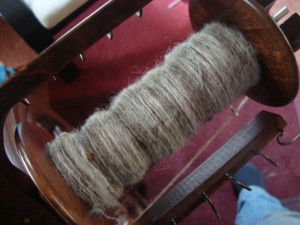
Doesn’t she have a lovely fleece? I liked it well enough in the roving, but it wasn’t until I started spinning it that I realized how beautifully heathered the gray is going to be. I have to admit that I have been struggling to resist the temptation to claim this wool as mine (as it was originally intended to be), but I am going to stick to the current plan. There will always be more fleeces, and I am getting to have a lot of sweaters!
One thing that has been very interesting about this set of projects is spinning from three fleeces from the same farm. You’d think they’d be pretty similar, given that they are three sheep fed and coated the same way, living in the same flock. The wool was presumably sheared by the same shearer and processed by the same mill. But the fleeces are not the same. As a reminder, MacGyver’s is the light gray wool in the sweater, and Magnolia’s is the dark brown.
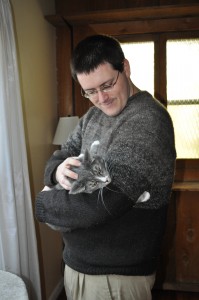
MacGyver’s wool was kind of downy, but had lots of heavier guard hairs in it. I tried picking them out as I went, but enough stayed in to make the sweater slightly prickly when worn on sensitive skin (fortunately, Branden doesn’t mind). As Branden has worn the sweater, the guard hairs have tended to poke out here and there, and we’ve been pulling them out over time. I’m not sure that it’s making much difference, but I like to think that the sweater is getting softer and softer with time. Either that, or we’re helping it to fall apart faster, but I’m sticking to the first interpretation. MacGyver’s was the first wool of the three that I spun, and it was full of little pills of short fiber, like the wool had been slightly tipped or there were second cuts in the shearing. I must admit that I was not looking forward to spinning three big bags of wool like that; pills in the spinning make me crazy. But the fiber was beautiful otherwise, and I loved the yarn, so I kept spinning.
Magnolia’s wool had none of the pills, and none of the guard hairs. It was a much thicker feeling fiber, very smooth and greasy, almost like alpaca. The pills must have been from MacGyver and not from the mill, since both Magnolia and Harriet’s fleeces are pill-free. Harriet’s fiber is different yet again. It is much lighter than Magnolia’s and very soft, Â more like the downy fleece in MacGyver’s wool. There aren’t many guard fibers at all, though there is a lot of hay. Harriet loved to wear her hay. I pull little bits out as I’m spinning, and I can’t help but imagine this sheep standing by her hay bale, munching away, pulling it down on top of her shoulders. Fortunately, most of it pops right out while I’m spinning, so it’s not a big deal, but it does amuse me to think of how this sheep must have always been wearing her food.
While I knit one sweater and spin toward the next, I’ve also been taking advantage of the beautiful weather to get outside and comb some more of my Gulf Coast fleece from last year. It is slow going, preparing a whole fleece by hand. I spun up most of what I had combed at Christmas to give to a friend, and I’ve only done a few ounces since then. It will be quite a while before I work my way through the whole 2.5 lbs, but it is very satisfying to see my bag fill up with these airy little puffs of fiber.
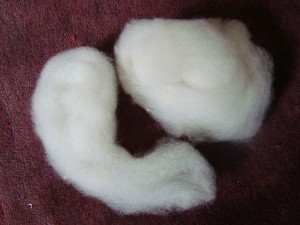
So there we have it. Handspun wool in all its stages. (Now all I need is a sheep.)
Fri 24 Feb 2012
I am yet again building up a list of small things going on behind the scenes that never quite make it to the blog. I think it is time for a catch up post.
Item the first:
I joined a new spinning group last month, and they have monthly workshops. I wasn’t terribly excited about the January meeting, because I’ve never been at all interested in needle felting. But I’ve found that one of the best things about being part of a group is trying things you wouldn’t otherwise do, so I went anyway. And I have to say I was pleasantly surprised. The poke-poke-poking went a lot faster than I had thought it would, and in the right frame of mind it’s even kind of relaxing. And, I really like the results:
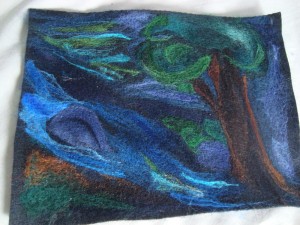
I doubt that I’m going to convert instantly to a needle-felting junkie, but it was just the right thing for my recover-from-interview  days last week. So, I started a flower.
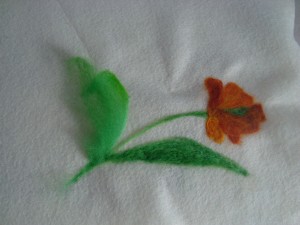
The nice thing about needle felting is that it finally gives me something to do with all the bits and pieces that I pull of of my fiber when I’m braiding it for the shop. There are always a few little pulls here and there, and the ends usually get a little felted, so I end up with a small handful of fiber from almost every colorway I make. I’ve been putting them aside as too good to throw out, and now I have quite a fun palette.
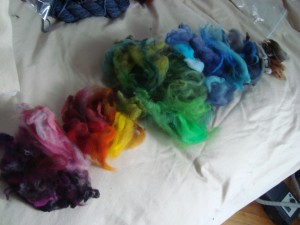
Moral of this story: Never assume that you are immune to any fiber craft, no matter how improbable it seems. (At least not if you’re me.)
Item the second:
The striped shawl sweater is now behaving beautifully. There were an awful lot of big bumps getting onto this road, but now that I’m on it I think it’s going to be much smoother. The points in the front are falling exactly where I expected them to:
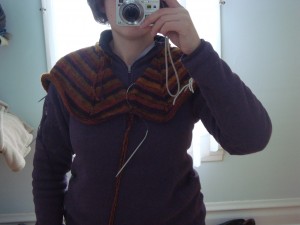
And the back is also laying nicely now.
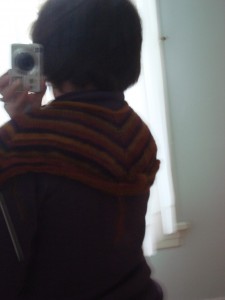
I’m not quite to the arm split yet, but if we get there without any more bumps in the road, then I think we’re home free.
Item the third:
I also finished spinning up the first “extra” skein of yarn for the main body of this project. I wasn’t sure how it would turn out, considering that I’d dyed the two batches of wool over 2 years apart.
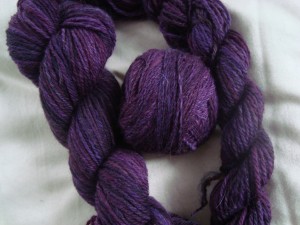
The ball in the middle is the old skein. The two on the sides are the new. I think that’s a pretty good match, don’t you?
I’m hesitant to attribute that to anything other than dumb luck, but I am pretty thrilled that I managed to get more of the same colorway after all this time.
Item the fourth:
Since I have now fully accepted that the striped shawl sweater is in fact going to be a sweater and not a shawl, that means that I have no good excuse not to just finish the shawl and be done with it. I sat down with my stitch dictionaries, and almost immediately stumbled across the perfect edging in Knitted Lace of Estonia. I spent days and days looking for border patterns last time I was working on this shawl, and this time it just fell into my hands. I’m taking that as a sign.
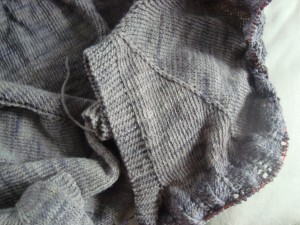
Unfortunately, each row takes about 45 minutes to knit, so it’s not exactly flying off the needles. Still, it’s making progress, and it should be ready to bind off soon. Yay for finished objects!
Item the fifth:
I was in need of a project that felt like it was going somewhere, so I whipped up a little instant gratification last weekend. I had just finished spinning up my sample of the Rambouillet top, with the aim of making a hat for Branden. It really doesn’t take long to knit a hat in worsted yarn, especially when it’s just a simple, simple hat with a little short row shaping.
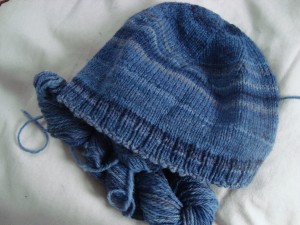
I was hoping for a modeled shot, but that’s why it hasn’t been blogged yet, and I bet you can imagine what a hat looks like on a head. I tried taking photos in the mirror, but it’s amazing how hard it is to take a picture of your own head.
I love how the colors came out on this one. They’re a tad bit greyer than they look in the photo, but I love those stripes. I ended up with about 220 yards of yarn, and the hat took almost precisely half. There should be enough left for a pair of handwarmers, too.
Item the sixth:
I have finished the first sleeve of the lace ribs sweater. I have no idea why this is taking me so long, besides the fact that I just don’t love knitting pieces flat. I usually do everything in the round, but the lace needs seams to keep its structure, and so it must be knit flat. Somehow, this is just never the project that I pick up first.
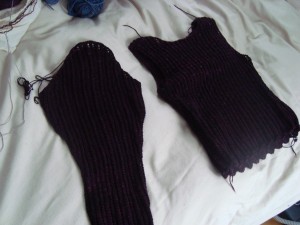
The good news is that the charts and instructions are almost done, so as long as the sleeve is actually the right size and shape after blocking, I should be almost done with the pattern.
The last item isn’t really an item, so much as it is something on my “must-catch-up” list. If I don’t get this fiber wrangled soon, it’s going to eat my office.
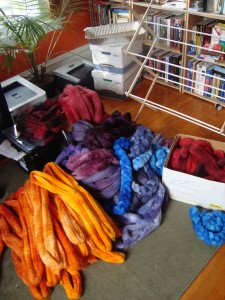
That is something like 48 braids worth of fiber. Those bankers boxes you see in the background? Also fiber, stuffed full to bursting. The stuff on the floor is waiting for photos and Etsy posting. Branden’s robotics team shipped their robot on Tuesday, so hopefully it will be a little easier to find time to take photos soon. (It’s kind of hard to find daylight picture time when he’s gone 4 days a week from morning until after I’m in bed, and at least half of the day on Saturday.)
Yellows and browns are next, but I’m holding off until after this batch is done. I don’t want to get swallowed up by the stash!
We’re almost all the way to a full rainbow now. I can’t wait to put them all together and see the full spectrum. And then, when the semisolids are done, I get to go back to the variegated colorways. So. many. ideas!
Sun 19 Feb 2012
This has been a busy week, but today I finally managed to sit down and draw up some new sketches for the striped shawl sweater. I’m in need of some mindless knitting, and there will be lots and lots of that once this design is actually on the right tracks (I think this time will be the charm). Since you are all so good at humoring me in my process posts, I thought I’d share the changes that I’m making.
(Incidentally, if you’re hoping for a pattern, you’ll note that the last sketch is really all you need. This whole design is all about putting double increase lines in the right place; after that, it’s just guessing how many stitches to cast on. I do plan to write this up as a pattern eventually, but who knows how long that will take…if a “recipe” is all you need, here it is.)
This is the sketch of the original verison:
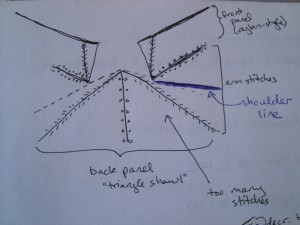
You can see that there are two different kinds of increase rows that define the main lines of my pentagon. If you squint, I think you can see them here (look for the yo lines, which are the ones with dots in the drawing above. The point of the shawl back is made up of yos).
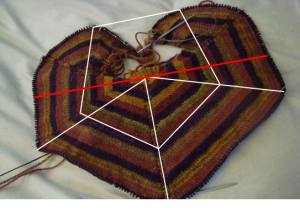
As we saw before, this led to too many stitches in the back panel, and I’ve decided that this is best fixed by changing the position of the shoulder line (shown in red on the photo, and in blue on the drawings):
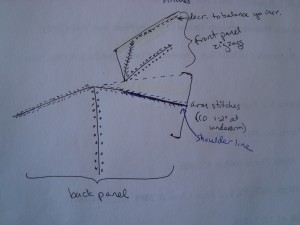
By rotating that shoulder line onto my double lifted increases (the line with the slashes), I got this:
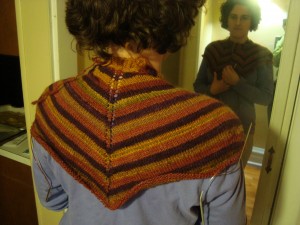
I’ll keep that increase line as the top of the shoulder and sleeve, which means that there will be more fabric to deal with in the front. It also means that those front yos fall naturally into position for the zigzag style.
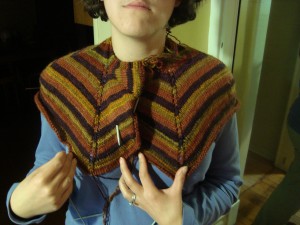
…which means that I just have to add decreases at the edge of the front panel to balance the increases that I’m adding from the yo column. (You can see that the fabric is folded over in the photo above to look like two separate front panels.)
This is also the part where I need to decide what to do about the neck. As you can see in the back shot above, rotating that shoulder line makes the back of the neck very high; it’s several inches above where it would normally be.
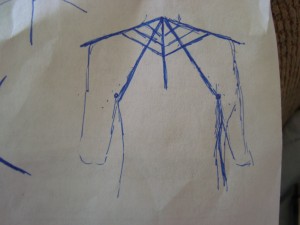
That’s not necessarily something that I mind, since I’m always cold and usually want something to cover the back of my neck anyway. But I’m thinking that I will probably eliminate the first full stripe repeat, and make my cast on sit at the beginning of that second purple row. That will be a more “normal” fit to the neck, and I think it will help with the fit in the front. You can see that the fabric is sitting a little funny at the front shoulders in the zigzag picture, and I think that cutting out that extra back neck will take care of that.
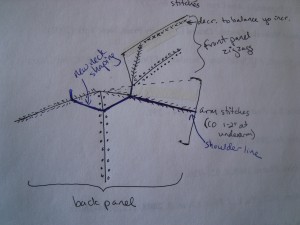
I’m also planning to eliminate the knit-on garter stitch edging, and instead plan to pick up and knit stitches to finish the collar. That gives me a lot more choice later to decide what I want the final collar to look like.
The last question is whether to keep that small triangle at the neck edge of the front panels. I really like how it wraps the stripes around and brings them vertical again, but I’m not sure how much of that will be preserved with the structural changes in the neck shaping. If I leave out that last set of lifted double increases, then that triangle will be eliminated, and I’ll have a v-neck opening something like this:
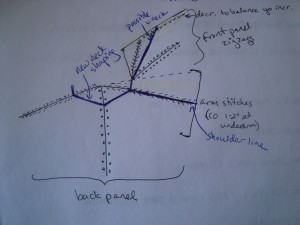
That would make a pretty deep v-neck, and the two front panels would probably meet right around the bra strap. Both Branden and Ellen suggested some kind of flap or lapel front, and this seems like the best option if I’m going to incorporate something like that. I’d probably use a solid purple to match the hemline, and just pick up stitches to add it on at the end. It would add another diagonal line to the front panel, and it might also cover up some of the zigzag look near the neck. It would decrease some of the busyness of the design by adding a solid area in the front panel, as Jocelyn (I think?) had suggested earlier.
I’ve been planning this as a zippered cardigan, so I want something that can be either open or closed, but I don’t think that a solid v would take too much away from the zigzags, especially if it came up into a high solid collar.
Making this change would mean that I’d lose those vertical stripes that I like so much, but I think that might actually be better considering how busy this design has become already. With all of those changes, I think the final sweater will look something like this (though the v-neck will probably end up a little deeper, and the shoulders will probably be a little more like a raglan and a little less like a set-in sleeve):
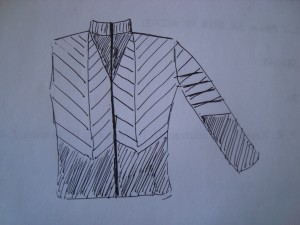
I think I like it.
Fri 10 Feb 2012
Insanity: Doing the same thing over and over again and expecting different results. Â ~Albert Einstein
After realizing that my latest “fix” has still not fixed the striped sweater, I finally sat down today to figure out what is really going on. I’ve been tweaking one thing after another, but clearly there’s something bigger going on that just isn’t working. Whenever I get to this point, it’s time to stop and reevaluate to see what I’m missing. Part of the problem is that I didn’t start this project expecting it to be a sweater, and so I hadn’t gone through all the design thinking that I’d usually do before casting on. So this afternoon, I sat down and looked at it very hard.
And I realized that it’s not a hexagon. It looks like a hexagon, doesn’t it?
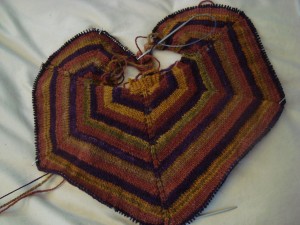
But it isn’t. Those angles are not 60 degrees. In fact, they’re much closer to 72 degrees, a fact which quickly explained all the problems I’ve been having.

Instead of splitting my fabric right down the middle, the shoulder line I’m using puts 3/5 of the fabric in the back panel. I had used a different shoulder line in the first picture:
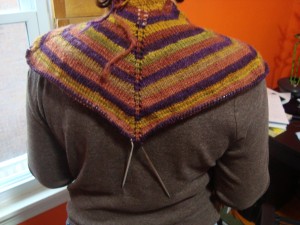
You can see that the first one has the increase line right along the top of the shoulder, but I’d moved it into a more traditional Raglan position in the later versions.
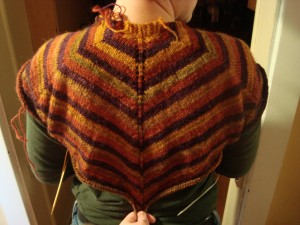
The Raglan line gave me a better fit on the neck, and would have been the perfect solution if I were working with a hexagon, since the stitches would have been evenly divided between front and back.
But I’m not working with a hexagon.
I’m going to have to pull back the latest fix anyway, but tonight I tried it on to check that changing the shoulder line is the right thing to do.

It is. The trouble is, moving the shoulder line puts all those extra stitches in the front, so now I need to figure out what to do with them there.
I’ll definitely have to cut a bunch of them out, but the question is: which ones?
I can take some stitches out of the shoulder area to preserve the pentagon shape and make Raglan shaping in the front. This is very close to what I was expecting with the previous design. The Raglan is a pretty safe option; horizontal stripes aren’t my favorite thing ever, but it’s a classic design and I know I won’t feel too obtrusive wearing it.
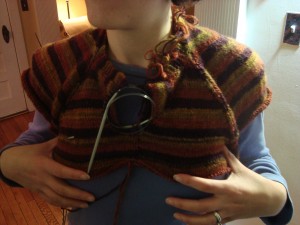
Or, I could take the stitches out of the front panel. I like the stripes going up over the shoulders in this one, but I’m not sure I like the front placket. Something in it feels very Pride and Prejudice to me (not that that’s a bad thing, but it’s not quite where I was expecting this design to go). Â Still, I think this one has the potential to grow on me.
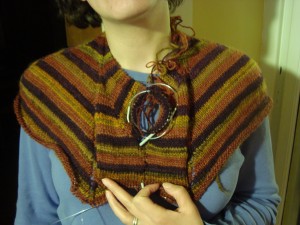
The last option is the one that has me most intrigued, but it also has the most potential to go wrong.

This is just another way of taking increases out of the front panel. I think the zig zag effect is interesting, but I’m not sure about adding two more “arrows” to this design in potentially attention-grabbing places. I’d continue the stripes down to mid-waist to match the back, which I think would reduce the arrow effect, but I really don’t know how I feel about this one. My first thought was that I absolutely didn’t like it (clown ruff, anyone?), the second thought was that maybe it wasn’t so bad, and now it’s kind of refusing to step aside.
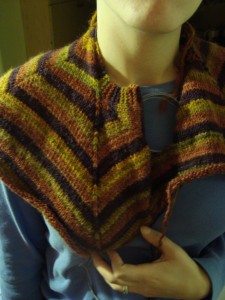
I like the look of it better when the front is open, and it does do a good job of highlighting the geometry.
Branden is strongly in favor of the zig zags, followed by the front placket, leaving the Raglan in last place. Raglan is low on my list, too, except that I don’t have to worry about whether or not I’ll wear it. The other two are still fighting it out in my mind.
Thoughts?
Wed 30 Nov 2011
I’m afraid I’ve been knitting and spinning more than I have been posting lately, and I am developing quite a backlog of things to tell you about. For tonight, I think we’re a bit overdue for an update on the Fall Colors sweater, yes?
Over the past couple of weeks, I have been turning this:
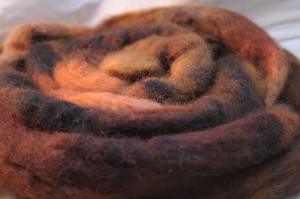
into this:
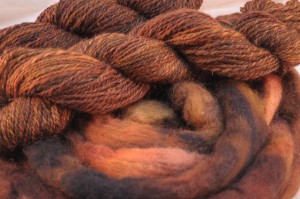
(Actually, I’ve finished all the brown, but I really liked the comparison of the original top and the final yarn.)
The Finn didn’t get at all sticky this time, and it has been absolutely beautiful to spin. It’s a nice fiber even when I get it wrong, but when I get it right, it’s amazing.
The colors also came out really well on this one. They ended up a little lighter than I expected in the final yarn, so I may have to overdye a bit at the end to darken it up a bit. I was expecting to get the balance shown in the first color; mostly dark with a few light spots for contrast, but it came out just the opposite. I’m working to come up with a design modification that will let me get around overdyeing it, though, because I really, really want to keep all those subtle color changes in the yarn. (I have been agonizing over this enough that there have even been suggestions that I should just dye up more fiber in a darker color and keep this yarn for something else. It is a tempting offer, but I think I can make it work.)
When I dyed this fiber, I knew that I wanted to match the original red-orange colorway. I used the same brown dyes that I had used to accent the red-orange fiber, and then added in a tiny bit of the orange and even a little bit of green. You can’t see it too well in the photo above, but it’s there. I was surprised to see how much that came across in the yarn. There are sections where one ply is a deep, olive green instead of brown, and a couple of spots where it lightens up almost to orange. I’m hoping that will help to tie the colorways even closer together in the final piece.
I used the same strategy for the green, dyeing it with the orange as a base dye and adding teal to make the green I wanted. Then, I threw in some dabs of brown here and there, and a slightly lighter green to brighten things up.
So far, I think they go really well together.
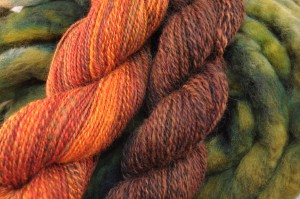
I started spinning the green at the Spinning Guild meeting on Monday. I can’t wait to see how it comes out!
Sat 12 Nov 2011
When I first envisioned the fall colors sweater, I thought it would be something lacy. Probably a cardigan, with vertical lace panels separated by some spacers. Something like this, perhaps:
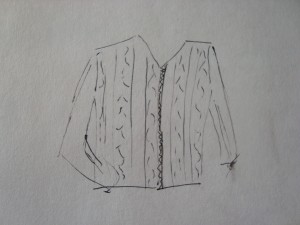
But then the issue of grist meant that I ended up with 30% less yarn than I’d expected from that fiber. Fortunately, I am working on the Falkland lace sweater at the same time, with the same yardage. So I have a pretty good idea of how far 928 yards will stretch.
The answer is that it will stretch enough, but only if I want a lightweight sweater with very open lace. I happen to love the way the Falkland sweater is coming out, but it’s probably not a weight that I’ll use for more than a few months a year, and definitely not in the fall. Also, I think that a lace that open really needs a semi-solid yarn to keep the color from fighting with the lace pattern. This yarn might work in a more solid lace, but I think it would be too much variegation for a really open pattern.
So that sent me back to the drawing board. Somewhere in our emails back and forth, Jan suggested that maybe a Chanel-inspired jacket would be the thing. This had me enchanted for quite a while, trying to figure out how I might stretch the yarn to make it work. It would have to be a short jacket because of the yarn restrictions, but I could use a different color as trim to help stretch it out a bit.
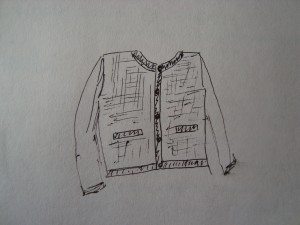
Unfortunately, I’d want this to be a really solid, stable fabric, probably with an almost woven texture. And that spells heavy yardage requirements. I thought about using two colors at once and dyeing something to match, but I still don’t think that will stretch the yardage enough.
I also thought about actually weaving it. You get a lot more fabric for the yardage with weaving than you do with knitting, so I could make this go farther on the loom. I’d also be using a different yarn for the warp, so I’d automatically get twice as far. I did some calculations, and really looked carefully at what it would take to cut these pieces from the widest fabric I can make on my loom, and I think it would still be cutting it a little too close. If I wanted a really cropped jacket or short sleeves I could probably make it work, but I think I’m unlikely to have occasion to wear either of those styles very often.
So. Definitely keeping this jacket idea in the active list, but probably not in this yarn. I think it would look great knit up, though.
Then I thought about working a more fitted jacket and having the sleeves in a contrasting color. The extra fitting takes out a significant portion of the yardage, and the contrasting sleeves cut out a lot more. If the body were worked in two colors, I might have enough to make it on this design. Based on the gauge of the Falkland sweater, I still don’t think I could get the full vest out of the fall colors yarn in stockinette. But colorwork might just do it here.
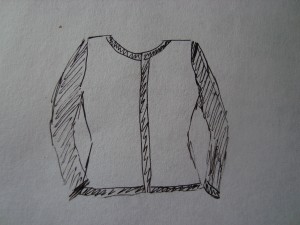
Next, I started thinking raglans. These are nice and simple, because you just start at the top and knit until you run out of yarn. They’re also very safe projects for me, because I’ve done enough of them to know that it will turn into something I’m likely to wear. (Though, incidentally, I have yet to actually knit myself a raglan.) I was thinking of something like this, minus the gorilla shoulders:
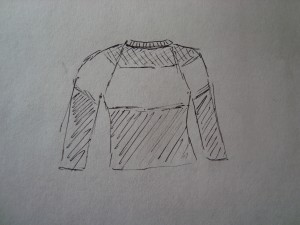
Olive green semisolid at the neck would put a spacer between the orange and my skin tone (one of the reasons that I don’t wear orange much is that I have a good bit of yellow in my skin and sometimes yellow/orange can make me look jaundiced). Then I’d do a dark brown for the main body, tying in both the greens and browns of fall. This could work, and it was actually my #1 choice until I sat down and started drawing these out. Seeing it on the page, though, it’s not quite as appealing as some of the other options. It’s still high on the list, but I’m not sure it’s right for this yarn.
I could also do some kind of colorwork or striping to spread the orange highlight yarn out over the entire sweater.
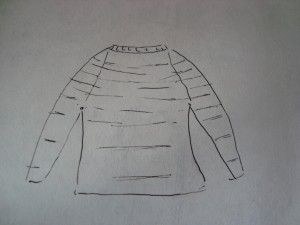
If done well, I think this could be absolutely stunning. Unfortunately, artistic arrangement of stripes is not my greatest strength. I am usually a little too mathematical and geometrical to come up with the kinds of dynamic striping that I’d want here. The sketch makes it look rather unappealing, doesn’t it?
I could do a raglan design with the fall colors yarn as an accent band, but I want it to stand front and center in the design, and I’d like to use up the yarn that I have. (Yes, I know. I am picky, picky, picky in the design phase. That’s why I usually end up with things that I like in the end.)
My current favorite leans back toward the more tailored jacket look, and is loosely based on a commercial sweater that I wear all the time.
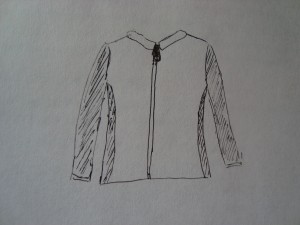
This would be a zip-front cardigan that’s fitted but still has a good bit of ease. It’s a more casual cut, so I’m more likely to wear it often. The seam between the side panels and the front fabric would give it a nice silhouette look, especially if there’s a strong contrast between bright body and dark panel colors. The sleeves could be a contrast color, and the underarms would be a solid or semi-solid to match the sleeves. That would take out a good 8″ of fabric from the body alone, helping the yarn to stretch further. The rest of the body could then be colorwork or a two-color textured pattern to stretch the yardage again (which should make up for the extra density of the fabric). I’d probably do an olivey-green for the sleeves and underarm panels, and a deep, dark brown for the other body yarn.
This could be done with any number of colorwork or texture designs. The dark brown should help the orange to “pop”, like the dark branches highlighting the fall foliage. Adding in the green and brown also pulls this closer into my usual color palette and might make it more likely that I’ll wear it often.
I’m a little torn about that last part. Practically speaking, I do think that I’m more likely to wear greens and browns than just orange. I was kind of in love with the pure orange-reds, though. The strong, bold colors are the whole point of this project, after all. I don’t want to dilute them down. I also don’t want this to be something that has to be worn as an earth-tone; I like the idea of making it a real focus piece. I think that I should be able to come up with a colorwork design that uses the darker colors to highlight the oranges, though. If I’m good, I should be able to use the design to narrow the focus even further, from the garment level right down to the individual yarns.
I don’t know if I’m that good, but I think I want to try.
The other slightly scary thing about this design is the construction. I haven’t done much designing for seamed sweaters, so this one will be a bit of a stretch. Add to that the fact that there will be 5 body panels, and that’s a lot of planning. I’m thinking of doing it with steeks, which will let me do the colorwork in the round and then seam at the end, but that means no trying on and checking of design along the way. It will also be a very oddly shaped garment until the steeks are cut.
I think that’s manageable, though. Those lines aren’t really very complicated, and I really like the semi-tailored look that the side panels give to the design. It’s not a closely fitted garment, so there should be some room to adjust at the end, if necessary. It would also give me a reason to steek a full sweater, which very much appeals to the seamstressy side of me. The colorwork and contrasting sleeves will guarantee that I have enough of the focus yarn, and I can dye and spin up as much as I need of the other colors.
So, I think this is it. Still dithering, poking around and exploring other ideas. I’d still need to sit down and figure out how much more yarn I need to spin, and to decide on the perfect colors to match. Solid? Semi-solid? Something else?
So many decisions still to make, but I think we’re getting closer.
Sun 23 Oct 2011
I finished plying the Fall colors yarn last night. Here it is as singles:
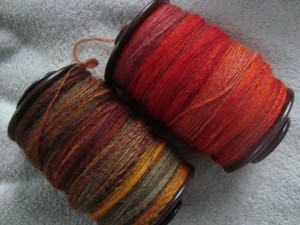
And here is some of the final yarn with the unspun fiber:
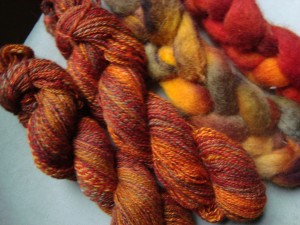
It’s funny; I loved it as single plies on the bobbin, hated the 2-ply yarn as I spun, and then fell in love again when I saw the skeins all laid out. I’m not sure what it was about the bobbins of plied yarn, but I very seriously considered stopping, switching to Navajo plying, and calling it a bust.
Now, I’m glad that I didn’t.
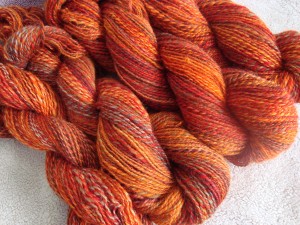
I love the way the colors mix in the skeins. Each strand looks like a different colorway, but somehow they all go together.
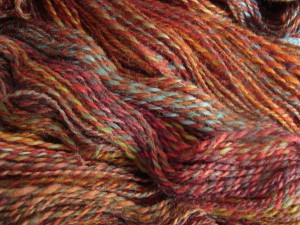
See those blues and greens in there? There’s even some gray. I’m not really sure where they came from, but I’m glad they stopped in for a visit. This section of the skein seems to contain an entire rainbow:
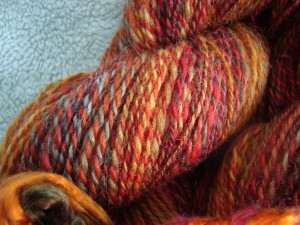
The color mixing reminds me of the yarn for my sunset sweater, which knit up beautifully in the end. I’m excited to see what happens with this…I think it will make for a similarly interesting knit.
The only thing missing is yardage. You may remember that I spun 8 oz of Falkland a while back, and ended up with 950 yards. That’s a pretty good yield for 8 oz, but it’s a little shy of what I’d like to knit a sweater, even a lacy one.
When I dyed the fall colors fiber, I went up to 12 oz of Finn. I figured that should give me 1100-1200 yards, which is much more within my comfort range for a sweater. You can see that the two fibers spun up to very much the same weight.
(Yes, the Falkland has changed color since you saw it last. More on that soon…I told you I was behind with the blogging.)
So, I used 50% more fiber, spun it up to the same weight, with roughly the same amount of twist, and what do you know? I got 978 yards from the Finn.
That is twenty.eight. yards more than my 8 oz of Falkland. I counted twice. I reweighed the skeins to make sure it was really 12 oz. I walked around the house muttering “28 yards!” to myself all last night. But so it is.
It appears that I have run smack dab into the problem of grist. Grist is to spinners what gauge is to knitters, which means that it’s something you don’t really think much about until something really nasty happens and you want something to blame. Well.
Grist is a standard way of describing weaving yarns, and it’s usually given in yards per pound. It has to do with the weight of the yarn, the loft of the fiber, the amount of twist and numerous other factors that I’m sure I’m missing. The bottom line is that it tells you the density of the yarn, and the density of the yarn is a very important factor in deciding how many yards you will get from a given weight.
It appears that Falkland has a higher grist than Finn. About 50% higher, to be exact. I knew that Falkland was fluffy stuff, but I didn’t realize just how much fluffier it was until last night. I am in even greater awe at the fluffiness of Falkland, because I would never call that Finn a dense or heavy yarn.
I’m also wondering if this result has something to do with the fact that I spun the Falkland before dyeing and the Finn after. I fluff my fiber up again before spinning it, but it does compact a bit during dyeing, and maybe this fiber just never bounced back all the way. It bears investigating, and has been added to my list of Very Important Questions to be answered. Until then, it appears that I’ll be working on another lacy sweater with slightly less yardage than I think I need. Â But at least it is pretty yarn…
Sat 8 Oct 2011
There has been lots of crafting going on around here lately, despite the time crunch from the commute (or perhaps because of it – being busy has a way of focusing my energy and getting a lot more done in less time).
The fall colors are starting to appear on the trees all around us. Just this week, the edges of the highway have gone from green to reds and yellows. The tree in front of our house is an explosion of gold and orange. I’m delighted to say that some of those colors are also showing up on my spinning wheel:
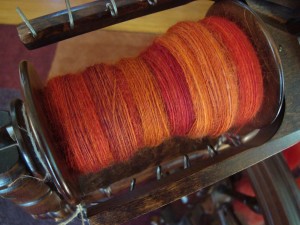
That’s the “reds” colorway for the fall colors sweater. Â I think it’s going to work. Very excited.
Branden’s sweater has been growing by leaps and bounds, since rounds and rounds of endless stockinette is the perfect way to come off of a 2 hour traffic jam. I bound off the body last night, and have started the first sleeve. I love knitting Branden raglan sweaters; the construction means that the sleeves are already knit to the armpit by the time I split off onto holder needles, so finishing up the rest is much faster than knitting the whole thing in one go.
With that getting so close to done, I’m starting to scramble around for another project for the queue. I think I’m going to dye up that Falkland that I spun a few months ago. Â I’ve been dithering about whether or not to order more fiber and spin some more, just to be sure I’ll have enough. But I do have 950 yards, and I know which lace I want to knit and what color, and I think I might have enough. (Plus, I’m itching to knit it, it’s half designed already, and I am not feeling patient. True confessions.)
I just finished setting the dye on some samples, and I’m pretty sure I have the colors I’m looking for when they’ve cooled enough to check. Fingers crossed that it comes out like I expect, and I’ll be dyeing the yarn tonight or tomorrow, and swatching soon thereafter.
I’ve also been slowly chipping away at teasing open the locks on the Gulf Coast fleece. This isn’t my favorite part of fleece processing, truth be told, so I have to do it in spurts here and there. But on Tuesday I finally washed everything one more time to (hopefully) get out the last of the lanolin, and I now have quite a pile of fluff in the basement.
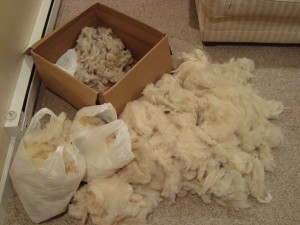
That little bit in the box is all that I have left to tease open and rewash, and I’m hoping to do that today, since it means that I can go sit outside and enjoy this glorious weather we’ve been having. Once the washing is finished, I’ll move onto the combing/carding, which should be more fun, since it will get me that much closer to actually spinning the stuff!
I dropped Branden off at the airport this morning; he’s on his way to Austria for a week for work. That leaves me the whole weekend and most evenings to putter around on fiber things, so I’m hoping to finish up a few more loose ends. Or I may just sit and spin the rest of that fall fiber, as it is begging me to do. Doesn’t sound like a bad plan, really.
For now, I’m off to wash those samples and see what new colors await!






















































